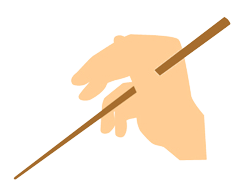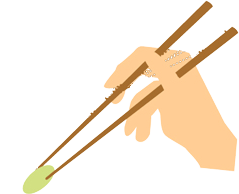
Using chopsticks does not come naturally for many, but a determined gentleman is undaunted by small, easy challenges such as this.
The History:
Chopsticks have been around for over (as far as anyone can tell) three millennia. They likely evolved as cooking utensils used for stirring and manipulating ingredients. Over time, they made their way to the dinner table at home and even the palace. Throughout southeastern Asia, different sizes and shapes can be found to have evolved from these culinary weapons. But unanimously, they beg one thing above your average fork or spoon: talent.
The Position:
To properly hold chopsticks, hold one of the them as if you were holding a pencil two thirds of the way up. Then take the other chopstick and slide it between thumb and forefinger while gently pressing the ring finger to the bottom chopstick. To move the chopsticks, move only the index and middle finger to guide the tip of the upper chopstick down where it meets the tip of the bottom one.
 |
 |
 |
 |
The Habits:
Beyond knowing how to hold chopsticks, table manners are also necessary for the true worldly gentleman. Never stick chopsticks into a bowl of rice or pass food directly from one pair of chopsticks to another as those are rituals in Buddhist funerals. (Posting your chopsticks for a quick rest may be a strong message to ancestors you hadn’t recently thought of talking to).
It is also impolite to spear food with chopsticks, point with them, or wave them around aimlessly. That is Japanese efficiency, as Tiger Tanaka pointed out.
Once you have eaten directly with the chopsticks, manners for sharing or sampling align to some extent with western practice. Use the opposite end of your chopsticks to pick up food from communal plates. Then before eating, one should say “Ittadakimasu” and “Gochisousama deshita” afterwards.
It is also expected to lift rice bowls to the mouth to eat or make slurping sounds when drinking soup, tea, or eating noodles. This will tell your host how much you appreciate the flavor. Like “code switching” with new languages, you may need to tailor such practices for mixed company – say, for that corporate dinner at Gonpachi in Tokyo.
Once you have mastered the proper use of chopsticks and table manners, you are then ready to enjoy all sorts of Asian foods. As James Bond said to Blofeld’s henchman, “Bon Appetit”.


